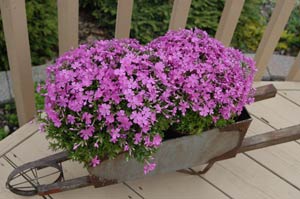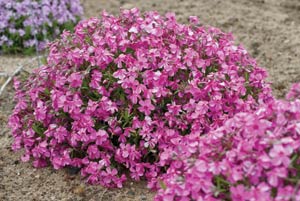10/15/2009
Keys to Producing Phlox subulata
Paul Pilon
Commonly known as creeping phlox,
Phlox subulata is a low-growing evergreen groundcover (6 to 9 in. in height) that naturally flowers in the spring. There are numerous cultivars available with vibrant shades of blue, pink, purple, rose and white blooms. In the early spring, there are few perennials that can rival the flower power of creeping phlox.
 Propagation
Propagation
Phlox subulata is best propagated from vegetative tip cuttings. For the best, fullest finished containers, begin propagation in the late spring (April to May) the year before the containers are to be sold. It’s not necessary to treat them with rooting compounds prior to sticking. When the liners are intended for large container sizes, stick multiple liners per cell to improve fullness of the final container. Provide low misting regimes for the first seven to 10 days of propagation. Begin feeding with 100 ppm nitrogen from water-soluble fertilizers at each irrigation as the cuttings begin to develop roots. Transplantable liners can be produced in four to five weeks after sticking.
Production
Creeping phlox prefers to be grown in very porous media with excellent drainage. During the bulking phase, pinching is recommended during production to promote lateral branching. Plant a single liner into small containers; it may be beneficial to plant multiple liners per pot when growing large containers (1 gal.). They perform best at light to moderate fertility levels (75 to 125 ppm continuous feed or 150 to 200 ppm as needed) and with slightly acidic pH (5.8 to 6.2). Creeping phlox can be grown under slightly below average watering regimes; i.e. keep them slightly moist but not wet during production.
Aphids, spider mites, stem and bulb nematodes and whiteflies are the most prevalent insect pests. Several fungal pathogens including botrytis, colletotrichum, downy mildew, fusarium, phytopthora, rhizoctonia, and thielaviopsis are commonly observed on creeping phlox. Of these pathogens, powdery mildew is the most prevalent. In most cases, these insects and diseases can be detected with routine crop monitoring and don’t require proactive strategies.
Due to their prostrate and slow-growing habit, it’s usually not necessary to control plant height. If height control is necessary, the plants can be toned using spray applications of daminozide at 2500 ppm tank mixed with chlormequat chloride at 1000 ppm or by applying paclobutrazol at 30 to 45 ppm or uniconazole at 7.5 to 10 ppm.
Forcing Guidelines
 To produce the fullest containers with the most bloom, it’s important to bulk creeping phlox in the final container prior to overwintering. The amount of time required for bulking varies widely by the container size being produced. Provide a minimum of two to four weeks for 4-in. containers and up to 12 weeks for 1 gal. pots. Using multiple liners in large containers will greatly reduce the amount of time necessary for bulking. Allow at least four weeks from the final pinch until the plants are overwintered.
To produce the fullest containers with the most bloom, it’s important to bulk creeping phlox in the final container prior to overwintering. The amount of time required for bulking varies widely by the container size being produced. Provide a minimum of two to four weeks for 4-in. containers and up to 12 weeks for 1 gal. pots. Using multiple liners in large containers will greatly reduce the amount of time necessary for bulking. Allow at least four weeks from the final pinch until the plants are overwintered.
Cold is required for the best flowering. Provide a minimum of eight weeks of vernalization at 35F to 44F (2C to 7C). They are day-neutral plants and will bloom easily under any photoperiod after the cold treatment. Flower buds are commonly visible by the end of the cold treatment or shortly after they’re exposed to warm growing temperatures. Phlox subulata can be forced into flower using a wide range of temperatures. Since they bloom so quickly in the spring, many growers prefer to grow them cool; they will flower in approximately three weeks when they are grown at 62F (17C).
Paul Pilon is a horticultural consultant, owner of Perennial Solutions Consulting (www.perennial-solutions.com), and author of Perennial Solutions: A Grower’s Guide to Perennial Production. He can be reached by phone at (616)366-8588 or E-mail at paul@perennial-solutions.com.